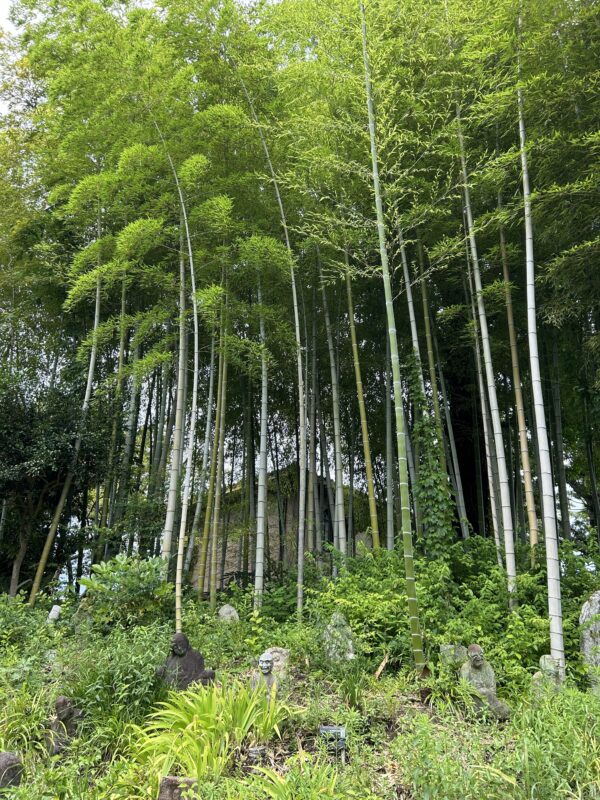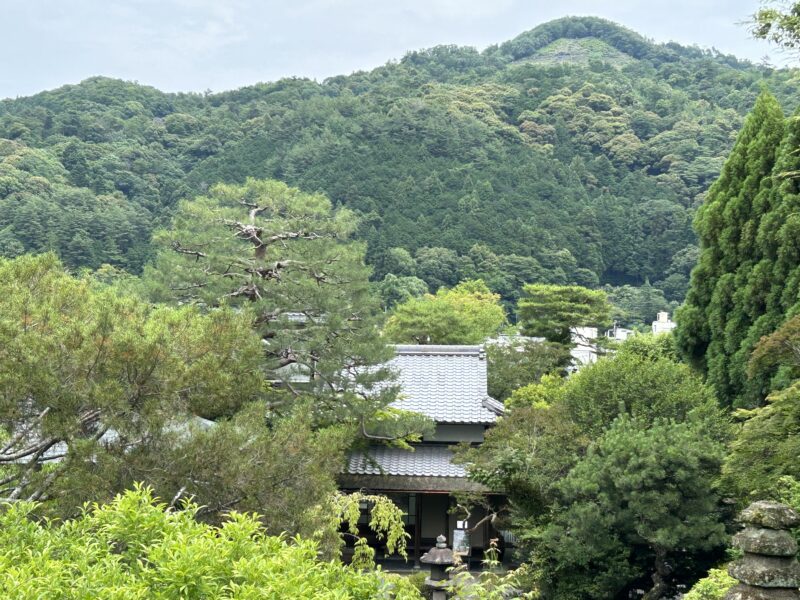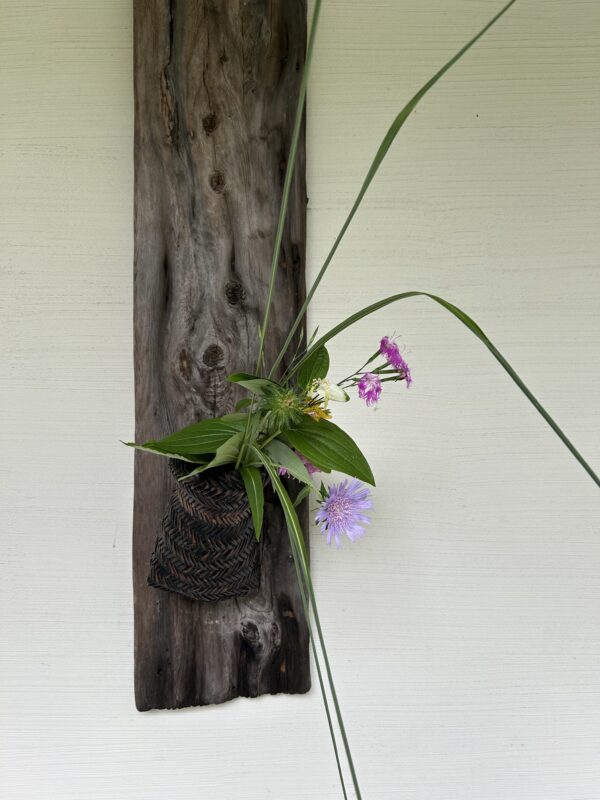
2024.08.12

前々回の哲学の道さんぽ その1に引き続き、今回も京都の右上のお薦めスポットをご紹介いたします。
美味しい朝菓子のコースをいただいた“かしはて”から徒歩5分のところにあるのが、
白沙村荘 橋本関雪美術館です。
銀閣寺前という観光客で賑やかなエリアですが、一歩足を踏み入れるととても静かで、
穏やかで平和な空気が漂っています。橋本関雪は1883年神戸生まれの画家です。
白沙村荘は関雪が生涯を掛けて造営し続けた邸宅でその中には画室、茶室、庭園、美術館があります。


入場チケットを購入すると、「最後の橋本関雪記念館MUSEUMの2階からは大文字を借景とした庭を
見る事が出来ますよ。」とご案内いただき、ワクワクしながら左手へと進みました。
広々と奥に続く日本庭園を「とんでもない財力に恵まれた画家だったのかな?」
と勝手な妄想を膨らませながら散策しました。
蓮池では元気いっぱいの蓮の大きな葉が池の水面を覆っていました。
残念ながら行った時期は6月末でまだ花が咲いていませんでしたが、
開花の時期が来ればそれはそれは立派な蓮池なんだろうと簡単に想像が出来るほど、
立派な蓮の葉だったのです。
鯉の泳ぐ大きな池に面している”存古楼”という大画室では、
大作屏風のほとんどが制作された部屋だそうで道場を思わせる様な広さがありました。
竹林の一角には沢山の石仏、石塔が贅沢に並んでいました。
それらは全国の寺院と神社に寄進した御礼に贈られたものだそうです。
これだけの御礼が届く大作を生み出した橋本関雪が日本画壇の大家の1人といわれる所以だなと
ただただ感心するばかりです。



庭を散策した最後に辿り着くのが橋本関雪記念館MUSEUMです。
この二階のテラスから如意ヶ嶽(大文字)を借景にこの白沙村荘の日本庭園を見る事ができます。
それはそれはとても贅沢な光景で、しばらくテラスの椅子に座って眺めていたのでした。
その二階では画集や小物類が販売されており、お土産を選ぶことができます。
最後に通る建物MUSEUMⅢで目にしたのは、大量のギリシャ・ローマ・ペルシャの陶器。
日本画家の邸宅でこれだけの海外コレクションが集まっていることにもまた驚かされました。
一通り見終わった後に、この記念館を維持されている橋本様にお話を伺うことができました。
四季を通じて様々な花を楽しむ事ができるこの記念館を是非多くの方に見ていただきたい
と望んでおられます。
白沙村荘前の通りには関雪が寄贈した桜並木があり、
”関雪桜”と呼ばれ春になると多くの人を楽しませているとのこと。
日本全国に寄進された芸術作品を生み出すだけでなく、
のちに記念館となる邸宅を生涯に渡り造営し続け、地域の美観にも貢献した橋本関雪。
また、それを大切に受け継がれているご家族の努力を隅々まで感じられる白沙村荘でした。
この立地で、この面積、そして数々の美術品がある事を考えると白沙村荘はまるで豪華すぎるほど
豪華な宝箱の様です。私も是非沢山の方に行っていただきたいなと思いました。

Following on from the blog Philosopher’s Path Walk Part 1, I would like to introduce another recommended spot in the upper right corner of Kyoto.
A five-minute walk from Kashihate, where I enjoyed a delicious morning pastry course, is Hakusasonso Hashimoto Kansetsu Garden Museum. Although the area in front of Ginkakuji Temple is crowded with tourists, once I step into the museum, I find it a quiet, peaceful atmosphere.
Hashimoto Kansetsu was a painter born in Kobe in 1883. Hakusasonso is the residence that Kansetsu spent his life building, which includes a painting studio, a tea ceremony room, a garden, and an art museum.
When I purchased my admission tickets, I was told, “At the end of the site, you will be able to see the garden with a view of Mt.Daimonji. As I walked through the spacious Japanese garden, , imagining that the painter must have been very wealthy.



Large lotus leaves full of vigor covered the surface of the pond. Unfortunately, the lotus had not yet flowered at the time I visited, but I could easily imagine that the pond would be a magnificent lotus pond when the blooming season came.
The large painting room called “Zonkorou,” facing a large pond with carp swimming in it, is said to be the room where most of the large folding screens were painted. The room was so spacious that it reminded me of a Kendo or Judo dojo, training hall.
In a corner of the bamboo grove, many stone Buddhas and pagodas were lined up luxuriously. They were presented from temples and shrines all over Japan as a token of appreciation for his paintings donations. I was impressed by the fact that Kansetsu, who created such large works, is considered one of the greatest painters in the world of Japanese painting.
At the end of my stroll through the garden, I arrived at the Hashimoto Kansetsu Memorial Museum. From the terrace on the second floor, I could see the Japanese garden with Mt.Daimonji behind the garden. It was such a luxurious sight that I sat on a chair on the terrace and relaxed for a while.
The last building is MUSEUM III, where I saw a large amount of Greek, Roman, and Persian pottery. I was again surprised to see such a large collection in the residence of a Japanese artist.
After I finished looking around, I had a chance to talk to Ms. Hashimoto, who maintains this memorial resident.
She hopes that many people will visit the facility. She said that one of the attractive point of here which offers a variety of flowers throughout the four seasons.
The cherry trees along the street were donated by Kansetsu, and they are called “Kansetsu Sakura” and are appreciated by many people in spring.
Kansestus not only created works of art that were donated all over Japan, but also contributed to the beauty of the local area by continuing to build a residence that later became a memorial museum throughout his life. The efforts of the family who carefully passed it down from generation to generation can be felt in every corner of the site.
Considering this location, this capaciousness, and the numerous works of art, Hakusasonso is like an overly luxurious treasure box. I hope many people will visit here, too.
Mikko
